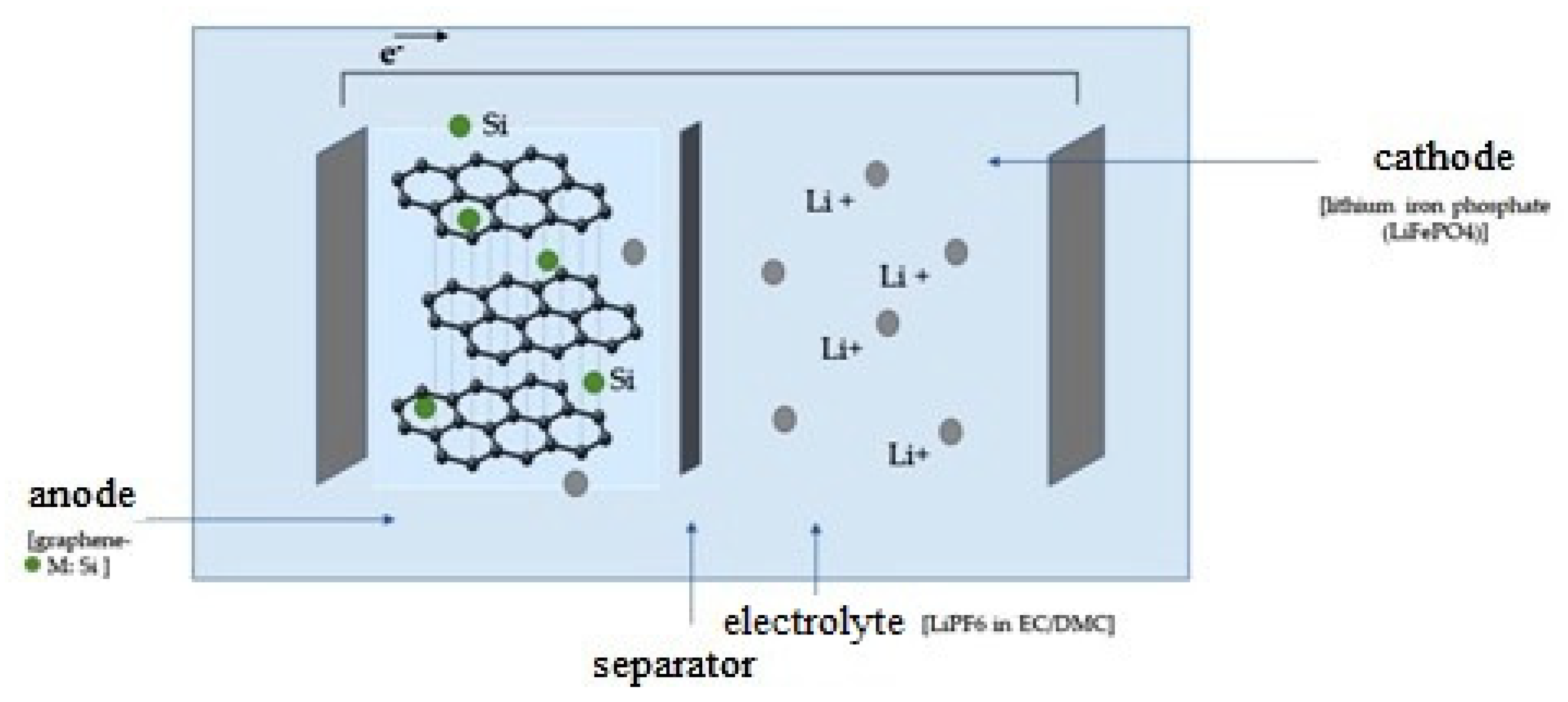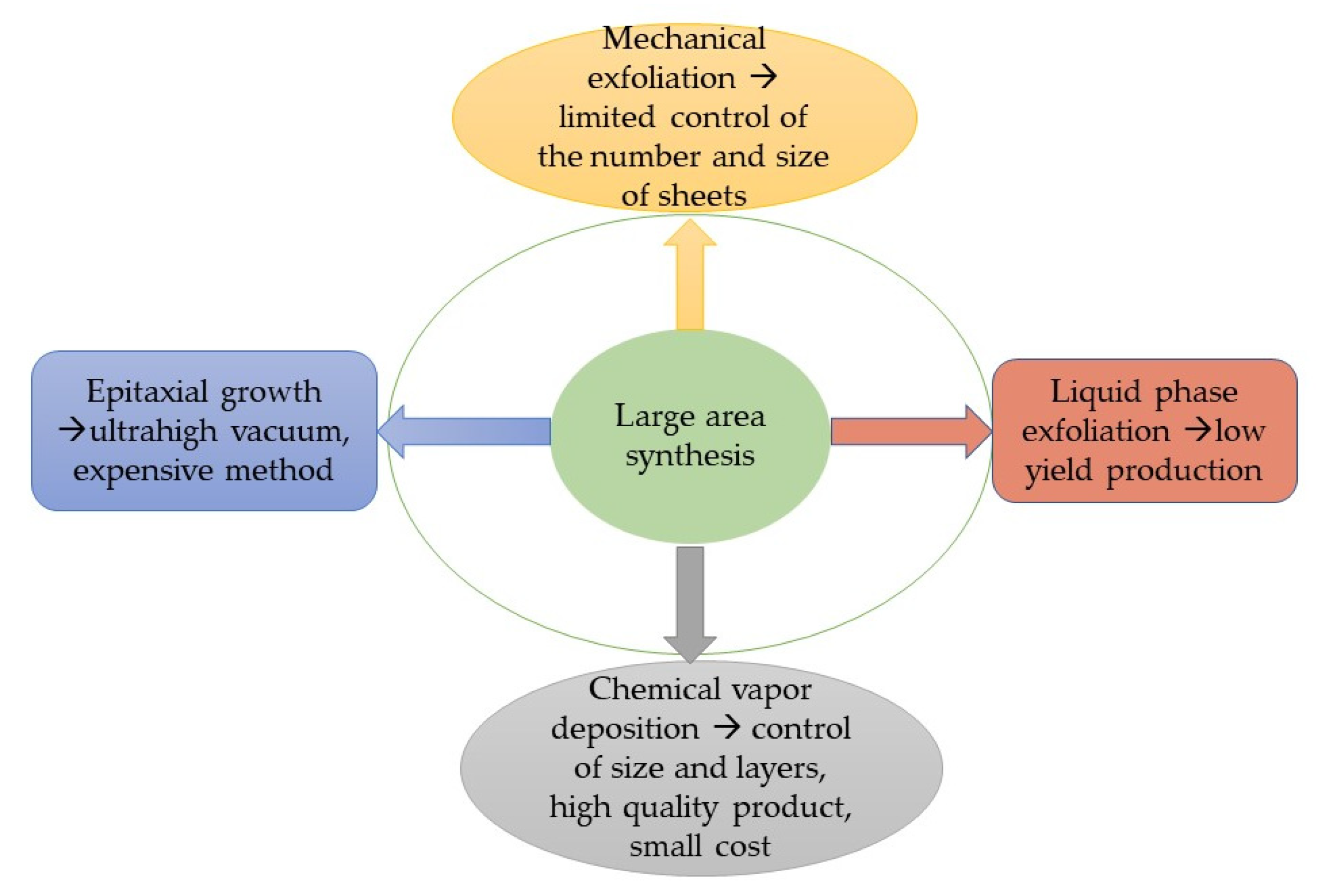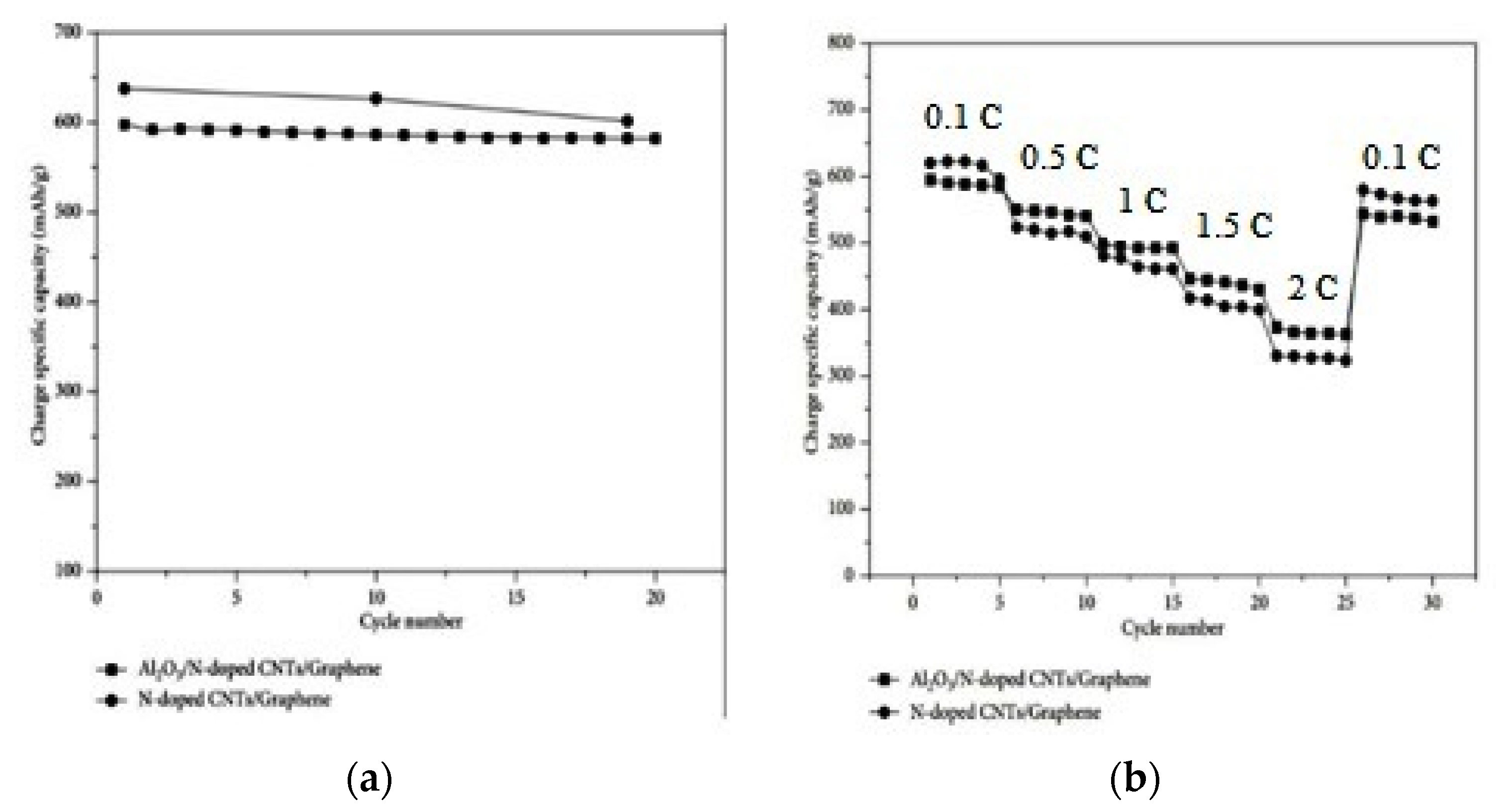APCVD Graphene-Based Composite Electrodes for Li-Ion Batteries
Abstract
:1. Introduction
2. Growth Synthesis of Graphene
2.1. Mechanical Exfoliation
2.2. Liquid Phase Exfoliation
2.3. Epitaxial Growth
2.4. Chemical Vapor Deposition
3. Electrochemical Performance of CVD Graphene-Based Composites
4. Discussion
5. Conclusions
Author Contributions
Funding
Institutional Review Board Statement
Informed Consent Statement
Conflicts of Interest
References
- Larcher, D.; Taracson, J.-M. Towards greener and more substainable batteries for electrical energy storage. Nat. Chem. 2015, 7, 19–29. [Google Scholar] [CrossRef] [PubMed]
- Cheng, H.; Shapter, J.G.; Li, Y.; Gao, G. Recent progress of advanced anode materials of lithium-ion batteries. J. Energy Chem. 2021, 57, 451–468. [Google Scholar] [CrossRef]
- Revankar, S.T. Techno-economic Integration of Renewable and Nuclear Energy. In Storage and Hybridization of Nuclear Energy; 2019; pp. 177–227. Available online: https://www.sciencedirect.com/science/article/pii/B9780128139752000065 (accessed on 30 November 2018).
- Jafari, H.; Rahimpour, M.R. Pb acid batteries. Recharg. Batter. Hist. Prog. Appl. 2020, 17–39. [Google Scholar] [CrossRef]
- Dufo-Lopez, R.; Cortes-Arcos, T.; Artal-Sevil, J.S.; Bernal-Agustin, J.L. Comparison of Lead-Acid and Li-Ion Batteries Lifetime Prediction Models in Stand-Alone Photovoltaic Systems. Appl. Sci. 2021, 11, 1099. [Google Scholar] [CrossRef]
- Ye, C.; Li, H.; Jaroniec, M.; Qiao, S.-Z. Roadmap for advanced aqueous batteries: From design of materials to applications. Sci. Adv. 2020, 6, eaba4098. [Google Scholar]
- Liu, Z.; Yu, Q.; Zhao, Y.; He, R.; Xu, M.; Feng, S.; Li, S.; Zhou, L.; Mai, L. Silicon oxides: A promising family of anode materials for lithium-ion batteries. J. Colloid Interface Sci. 2021, 589, 308–317. [Google Scholar]
- Zhao, S.; Li, M.; Wu, X.; Yu, S.H.; Zhang, W.; Luo, J.; Wang, J.; Geng, Y.; Gou, Q.; Sun, K. Graphene-based free-standing benda-ble films: Designs, fabrications. Mater. Today Adv. 2020, 6, 100060. [Google Scholar] [CrossRef]
- Xie, K.; Wang, J.; Wang, J.; Wang, P. Tunable electronic properties of free-standing Fe-doped GaN nanowires as high-capacity anode of lithium-ion batteries. Arab. J. Chem. 2021, 14, 103161. [Google Scholar] [CrossRef]
- Armand, M.; Axmann, P.; Bresser, D.; Copley, M.; Edström, K.; Ekberg, C.; Guyomard, D.; Lestriez, B.; Novák, P.; Petranikova, M.; et al. Lithium-ion batteries—Current state of the art and anticipated developments. J. Power Sources 2020, 479, 228708. [Google Scholar] [CrossRef]
- Deng, B.; Liu, Z. Toward mass production of CVD graphene films. Adv. Mater. 2018, 31, 1800996. [Google Scholar] [CrossRef]
- Karapidakis, E.; Vernardou, D. Progress on V2O5 cathodes for multivalent aqueous batteries. Materials 2021, 9, 2310. [Google Scholar] [CrossRef] [PubMed]
- Xing, B.; Zeng, H.; Huang, G.; Zhang, C.; Yuan, R.; Cao, Y.; Chen, Z.; Yu, J. Porous graphene prepared from anthracite as high performance anode materials for lithium-ion battery applications. J. Alloys Compd. 2019, 779, 202–211. [Google Scholar] [CrossRef]
- Abdalla, A.M.; Hossain, S.; Shaikh, S.S.; Dawood, S.B.H.S.; Azad, A. Nanostructured graphene materials utilization in fuel cells and batteries: A review. J. Energy Storage 2020, 29, 101386. [Google Scholar]
- Mohan, V.B.; Lau, K.-T.; Hui, D.; Bhattacharyya, D. Graphene-based materials and their composites: A review on production, applications and product limitations. Compos. Part B Eng. 2018, 142, 200–220. [Google Scholar] [CrossRef]
- Lu, Z.; Kong, Z.; Jing, L.; Wang, T.; Liu, X.; Fu, A.; Guo, P.; Guo, Y.-G.; Li, H. Porous SnO2/Graphene Composites as Anode Materials for Lithium-Ion Batteries: Morphology Control and Performance Improvement. Energy Fuels 2020, 34, 13126–13136. [Google Scholar] [CrossRef]
- Zhong, W.; Chen, Q.; Yang, F.; Liu, W.; Li, G.; Xie, K.; Ren, M. N, P dualdoped carbon nanotube with superior highrate sodium storage performance for sodium ion batteries. J. Electroanal. Chem. 2019, 850, 113392. [Google Scholar] [CrossRef]
- Wang, X.; Huang, R.Q.; Niu, S.Z.; Xu, L.; Zhang, Q.C.; Amini, A.; Cheng, C. Research progress on graphene-based materi-als for high-performance lithium-metal batteries. New Carbon Mater. 2021, 21, 711–728. [Google Scholar]
- Ding, S.; Cheng, W.; Zhang, L.; Du, G.; Hao, X.; Nie, G.; Xu, B.; Zhang, M.; Su, Q.; Serra, C.A. Organic molecule confinement reaction for preparation of the Sn nanoparticles@graphene anode materials in Lithium-ion battery. J. Colloid Interface Sci. 2021, 589, 308–317. [Google Scholar] [CrossRef]
- Su, M.; Liu, S.; Tao, L.; Tang, Y.; Dou, A.; Lu, J.; Liu, Y. Silicon-graphene composite prepared by spray–drying method as anode for lithium ion batteries. J. Electroanal. Chem. 2019, 58, 89–90. [Google Scholar]
- Xiaofu, T.; Guangwu, W.; Yan, S. Stable silicon/3D porous N-doped graphene composite for lithium-ion batteries with self-assembly. Appl. Surf. Sci. 2018, 436, 398–404. [Google Scholar]
- Sun, C.; Wang, Y.-J.; Gu, H.; Fan, H.; Yang, G.; Ignasznak, A.; Tang, X.; Liu, D.; Zhang, J. Interfacial coupled design of epitaxial Graphene@SiC Schottky junction with built-in electric field for high-performance anodes of lithium-ion batteries. Nano Energy 2020, 77, 105092. [Google Scholar] [CrossRef]
- Vernardou, D. State of the art of chemically grown vanadium pentoxide nanostructures with enchanced electrochemical properties. Adv. Mater. 2013, 4, 798–810. [Google Scholar]
- Kumar, R.; Sahoo, S.; Joanni, E.; Singh, R.K.; Tan, W.K.; Kar, K.K.; Matsuda, A. Recent progress in the synthesis of graphene and derived materials for next generation electrodes of high performance lithium ion batteries. Prog. Energy Combust. Sci. 2019, 75, 100786. [Google Scholar] [CrossRef]
- Ullah, S.; Hasan, M.; Ta, H.Q.; Zhao, L.; Shi, Q.; Fu, L.; Choi, J.; Yang, R.; Liu, Z.; Mark, H. Rümmeli, Synthesis of doped porous 3D graphene structures by Chemical Vapor Deposition and its Applications. Adv. Funct. Mater. 2019, 29, 1904457. [Google Scholar] [CrossRef]
- Cheng, C.; Jia, P.; Xiao, L.; Geng, J. Tandem chemical modification/mechanical exfoliation of graphite: Scalable synthesis of high-quality, surface-functionalized graphene. Carbon 2019, 145, 668–676. [Google Scholar] [CrossRef]
- Yang, C.; Wu, P.; Gan, W.; Habib, M.; Xu, W.; Fang, Q.; Song, L. Low temperature CVD growth of ultrathin carbon films. AIP Adv. 2016, 5, 055310. [Google Scholar] [CrossRef] [Green Version]
- Wang, C.; Vinodgopal, K.; Dai, G. Large-Area Synthesis and Growth Mechanism of graphene by chemical vapor deposition. Chem. Vap. Depos. Nanotechnol. 2018, 5, 97–113. [Google Scholar]
- Pham, P.V. Atmospheric Pressure Chemical Vapor Deposition of Graphene. Chem. Vap. Depos. Nanotechnol. 2018, 6, 115–134. [Google Scholar]
- Muñoz, R.; Martínez, L.; López-Elvira, E.; Munuera, C.; Huttel, Y.; García-Hernández, M. Direct synthesis of graphene on silicon oxide by low temperature plasma enhanced chemical vapor deposition. R. Soc. Chem. 2018, 10, 12779–12787. [Google Scholar] [CrossRef]
- Xu, S.; Zhang, L.; Wang, B.; Ruoff, R.S. Chemical vapor deposition on graphene on thin film metals. Cell Rep. Phys. Sci. 2021, 2, 100410. [Google Scholar] [CrossRef]
- He, J.-R.; Chen, Y.; Zheng, B.; Qi, F.; Lin, J.; Chen, X. Significant Performance Enhancement of Graphene Anode for Li-ion Batteries by Using CVD-Graphene-Film/Cu-Foil Composite Collectors. Mater. Sci. 2017, 388–392. Available online: http://dpi-proceedings.com/index.php/dteees/article/view/11871 (accessed on 23 April 2017).
- Wang, J.-B.; Ren, Z.; Hou, Y.; Yan, X.-L.; Liu, P.-Z.; Zhang, H.; Zhang, H.-X.; Guo, J. A review of graphene synthesis at low temperatures by CVD methods. New Carbon Mater. 2020, 3, 193–208. [Google Scholar] [CrossRef]
- Saeed, M.; Alshammari, Y.; Majeed, S.A.; Al-Nasrallah, E. Chemical Vapour Deposition of Graphene—Synthesis, Characterisation and Applications: A review. Molecules 2020, 25, 3856. [Google Scholar] [CrossRef] [PubMed]
- Lin, C.-C.; Hsu, S.-P.; Chen, G.-J. Effects of Alumina Films on N-Doped Carbon nanotubes/graphene composites as anode materials of Lithium-Ion batteries. J. Nanomater. 2020, 2020, 1–13. [Google Scholar] [CrossRef]
- Zhang, P.B.; You, Y.; Wang, C.; Fang, X.H.; Ren, W.; Yang, L.Y.; Chen, X.Y. A novel anode material for lithium-ion batteries: Silicon nanoparticles and graphene composites. IOP Conf. Ser. Earth Environ. Sci. 2019, 354, 012079. [Google Scholar] [CrossRef] [Green Version]
- Huang, Y.; Luo, J.; Peng, J.; Shi, M.; Li, X.; Wang, X.; Chang, B. Porous silicon–graphene–carbon composite as high performance anode. J. Energy Storage 2020, 27, 101075. [Google Scholar] [CrossRef]
- Yang, J.; Liu, J.; Zhao, C.; Zhang, W.; Li, X. Core-shell structured heterohierachical porous Si@graphene microsphere for high-performance lithium-ion battery anodes. Mater. Lett. 2020, 266, 127484. [Google Scholar] [CrossRef]
- Zhang, Y.-J.; Chu, H.; Zhao, L.-W.; Yuan, L.-F. Si/graphene composite as high-performance anode materials for Li-ion batteries. J. Mater. Sci. 2017, 28, 6657–6663. [Google Scholar] [CrossRef]
- Tan, Q.; Kong, Z.; Chen, X.; Zhang, L.; Hu, X.; Mu, M.; Sun, H.; Shao, X.; Guan, X.; Gao, M.; et al. Synthesis of SnO2/graphene composite anode materials for lithium-ion batteries. Appl. Surf. Sci. 2019, 485, 314–322. [Google Scholar] [CrossRef]
- Lin, C.-C.; Chang, P.-L. Synthesis of Carbon Nanotube/Graphene Composites on Ni Foam without additional catalysts by CVD and their nitrogen-plasma treatment for anode materials in Lithium-ion batteries. Electrochem. Soc. Jpn. 2017, 86, 109–115. [Google Scholar] [CrossRef] [Green Version]





| Graphene Composites | Synthesis Method | Electrolyte | Capacity |
|---|---|---|---|
| Carbon nanotube/graphene composites on Ni foam [41] | One step ambient pressure CVD (800 °C) | LiPF6 dissolved in 1:1:1 (v/v) (EC)(EMC)(DMC) | 597 mAh g−1 after 10 cycles |
| Si nanoparticles and graphene composites [36] | CVD (1000 °C) | A mixed solution of EC and DMC (1:1) with 1 M LiPF6 | 1115.2 mAh g−1 after 6 cycles |
| Porous silicon–graphene composite [37] | Freeze-dying and CVD (880 °C) | 1 M LiPF6 dissolved in the solution of EC and DMC (1:1) | 550 mAh g−1 after 820 cycles |
| Core shell structured heterostructured porous Si–graphene composite [38] | Acid etching and CVD (700 °C) | LiPF6 in EC and DEC (1:1, v:v) with 10 wt.% fluoroethylene carbonate additives | 1124 mAh g−1 after 120 cycles |
| Si–graphene composites [39] | CVD (1000 °C) | EC dissolved in 1 mol L−1 LiPF6 | 652.6 mAh g−1 after 50 cycles |
| Si–graphene composite [20] | Spray dying with low temperature technology | 1 M LiPF6 in EC, EMC and DMC (1:1:1 in volume) | 1298.1 mAh g−1 after about 5 cycles |
| 3D N-doped graphene/silicon composite [21] | Electrostatic self-assembly | 1 M LiPF6 in 1:1 (v/v) EC/DEC with 5 wt.% fluoroethylene carbonate | 1132 mAh g−1 after 100 cycles |
| Sn nanoparticles-2DLMG composites [19] | Hydrothermal treatment with spray drying or freeze drying, and calcination (organic molecule confinement reaction (OMCR) | 1 M LiPF6 in EC/DEC/DMC mixture (volume 1:1:1) | 539 mAh g−1 after 200 cycles |
| EG–SiC composite [22] | In-situ epitaxial growth of graphene coated SiC | 967.9 mAh g−1 after 200 cycles |
Publisher’s Note: MDPI stays neutral with regard to jurisdictional claims in published maps and institutional affiliations. |
© 2022 by the authors. Licensee MDPI, Basel, Switzerland. This article is an open access article distributed under the terms and conditions of the Creative Commons Attribution (CC BY) license (https://creativecommons.org/licenses/by/4.0/).
Share and Cite
Floraki, C.; Sapountzis, A.; Vernardou, D. APCVD Graphene-Based Composite Electrodes for Li-Ion Batteries. Energies 2022, 15, 926. https://doi.org/10.3390/en15030926
Floraki C, Sapountzis A, Vernardou D. APCVD Graphene-Based Composite Electrodes for Li-Ion Batteries. Energies. 2022; 15(3):926. https://doi.org/10.3390/en15030926
Chicago/Turabian StyleFloraki, Christina, Antonis Sapountzis, and Dimitra Vernardou. 2022. "APCVD Graphene-Based Composite Electrodes for Li-Ion Batteries" Energies 15, no. 3: 926. https://doi.org/10.3390/en15030926
APA StyleFloraki, C., Sapountzis, A., & Vernardou, D. (2022). APCVD Graphene-Based Composite Electrodes for Li-Ion Batteries. Energies, 15(3), 926. https://doi.org/10.3390/en15030926







